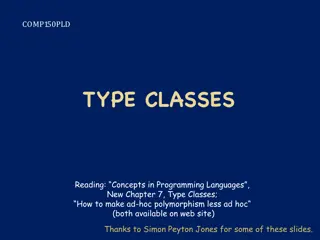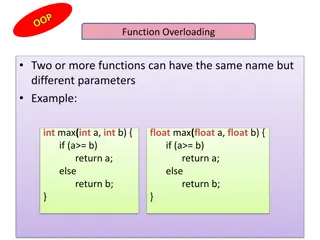
Constructor Overloading and Accessibility in Object-Oriented Programming
Explore the concepts of constructor overloading, encapsulation, and how to achieve low coupling and high cohesion in object-oriented programming. Learn about the importance of constructors, common mistakes to avoid, and how to fix them effectively.
Download Presentation

Please find below an Image/Link to download the presentation.
The content on the website is provided AS IS for your information and personal use only. It may not be sold, licensed, or shared on other websites without obtaining consent from the author. If you encounter any issues during the download, it is possible that the publisher has removed the file from their server.
You are allowed to download the files provided on this website for personal or commercial use, subject to the condition that they are used lawfully. All files are the property of their respective owners.
The content on the website is provided AS IS for your information and personal use only. It may not be sold, licensed, or shared on other websites without obtaining consent from the author.
E N D
Presentation Transcript
Introduction to Constructor, Overloading, and Accessibility CS340100, NTHU Yoshi
Outline Review blueprints and instances Constructor Overloading Accessibility 1-2
Class and Instances Review blueprint and instances Encapsulation 1-3
Class and Instances (2) Architect writes class Class instantiates objects 1-4
Encapsulation and Modularity Easy for Maintenance and Integration Lead to low coupling & high cohesion 1-5
Constructor The same name as the class Set the initial states and run the initial behaviors while constructing No return type class Vehicle { private int wheel; public Vehicle() { // // // wheel = 4; } } 1-6
Constructor (contd) Each class has at least one constructor If you don t give one, the default constructor will be created 1-7
Wrong Program (Why?) // Vehicle class Vehicle { Vehicle(String x){ System.out.println( Vehicle s Constructor ); } } public class App { public static void main(String[] args){ Vehicle obj = new Vehicle(); } } 1-8
How to fix it! // Vehicle class Vehicle { Vehicle() { } System.out.println( Vehicle s Constructor ); Vehicle(String x){ System.out.println( Vehicle s Constructor ); } public void drive(){ System.out.println( I m driving ); } Any other way? } 1-9
Overloading Also known as static polymorphism May be applied to Constructors Normal methods 1-10
Overloading Utility max() Utility.max(23, 45); Utility.max(23, 45, 87); Utility.max( a , z ); 1-11
Constructor with Parameters A class may have multiple constructors, and decided according to the parameters class Vehicle { private int wheel; Vehicle() { // // // wheel = 4; } Vehicle(int n) { wheel = n; } } // Vehicle newCar1 = new Vehicle(); Vehicle newCar2 = new Vehicle(6); // // 1-12
this this() this() 1-13
Example public class Flower { int petalCount = 0; String s = new String("null"); //String= null ; Flower(int petals) { petalCount = petals; System.out.println("petalCount= "+ petalCount); } Flower(String ss) { System.out.println( "s=" + ss); s = ss; } 1-14
Example (contd) Flower(String ss, int petals) { this(petals); //this(s); // Can't call two this()! s = ss; System.out.println("String & int args"); } Flower() { this("hi", 47); System.out.println("default constructor (no args)"); } void print() { //this(11); // Not inside non-constructor! System.out.println("petalCount = " + petalCount + " s = "+ s); } public static void main(String[] args) { Flower x = new Flower(); x.print(); } } 1-15
Information Hiding Protection Some properties are never modified Interface to programmers A programmer does not need to know the details, but use the interactive interfaces 1-16
Setter : public void setWheel(int n){ wheel = n; } Getter : public int getWheel(){ // wheel return wheel; } Can you give me a good setter/getter example? // wheel 1-17
Accessibility private (default) protected public ( instance) 1-18
Modifier public class (Default) package class protected package class package private class 1-19
Tips Use the most restrictive access level that makes sense for a particular member. That is, use private unless you have a good reason not to Avoid public fields except for constants 1-20
Example: Account public class Account { private int money; public void setMoney(int m) { if(m < 0) System.out.println("Error"); else money = m; } public void foo(Account otherAccount) { //private class otherAccount.money = -1000; } } 1-21
Summary We have learnt Constructor Overloading Encapsulation and information hiding Accessibility 1-22
References http://java.sun.com/docs/books/tutorial/java/ javaOO/accesscontrol.html 1-23






















